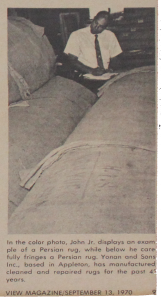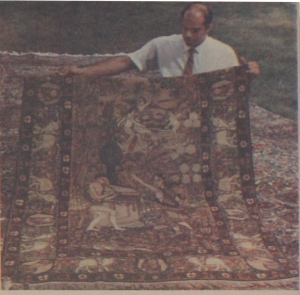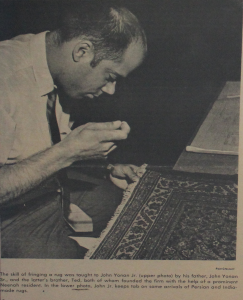Written for VIEW Magazine
by Dinah Walter
September 13, 1970
In these days of cut-rate, indoor-outdoor carpeting, two Iranian-born brothers have found that there is still a demand in the Fox Cities for exquisite Persian rugs as well as hand-made carpeting from India.
These somewhat rare but cherished “gifts of the Orient” are brought to the United States by an Appleton-based firm, which was founded by the brothers some 42 years ago.
Since 1928, Yonan & Sons Inc., headquartered at 103 W. College Ave., has manufactured, repaired and cleaned Persian rugs. For the past 22 years, it has done the same with Indian rugs.
“We go all out for the best rugs and the quality people can rely on,” says John Yonan Jr.
Not only individual home owners, but banks (locally the Kellogg Bank in Green Bay and Marine National in Neenah), loan associations, a golf course, a famous motel chain and businesses (in the U.S., Germany and Canada), have relied on the firm, which was founded by John Yonan Sr. and his younger brother, Ted.
While barely in their teens, John and Ted with the rest of the members of the family had to flee their native Iran because of an invasion by the Turks.
John Yonan Sr., who describes his life as a “fabulous experience,” recalled that the family of seven had 24 hours in which to escape. They traveled in two buggies, drawn by a pair of white Arabian horses, and left their Persian rugs and other belongings, behind.
After the horses died, they traveled by foot.
Following eight to 10 months of hard traveling, the family finally landed in Vancouver, British Columbia, on July 4, 1919. (“They thought the fireworks were meant for them,” John Jr. said.)
Not too long after, John and his older brother, Joe, neither of whom could speak much English, left for Charlotte, N.C. They had chosen this city because the Davidson Presbyterian College had established a Yonan scholarship in memory of David Yonan, a cousin of the family, who had attended the school, but had drowned while trying to rescue a friend.
Sought Out YMCA
Joe and John had heard about YMCA’s in Iran. Consequently, they sought out the Y when they reached Charlotte. After spending a night on the porch of the building, they were given jobs cleaning the building in return for a room.
Since they didn’t know English, their education had to start from the ground up. They enrolled in school at the first-grade level and were given individual instruction by a high school teacher named Minnie Downs.
In high school, John became interested in forensics and grew so adept in it that during his second year he placed second in oratorical competition in the school. He later was named number one in the state, was first among students in 13 southern states and second in a national contest.
While attending Davidson College and later the University of North Carolina, John gave many speeches on the topic of Iran and the Near East Relief Association, for which his father had worked.
These speeches eventually led him to the Fox Cities.
He first came to Neenah during the summer of 1923, as an employee of the Near East Relief Association. Later he attended the University of Michigan, and planned to go back to Iran as a missionary after school.
Previously, he had hoped to become a doctor, but his health prohibited that.
In 1926, John drove to Neenah with his father, who was living near Chicago. Here, he looked up a prominent Neenah citizen, whom he had met during his earlier visit to the city. He told the man he would like to get in the Persian rug business.
Having been given money by the man to obtain the rugs from Iran, John cabled his uncle in Iran to ship them. Before the rugs arrived, John, who was later joined by Ted, went throughout the state visiting people who either wanted the rugs or had Persian rugs but didn’t know anything about them.
The Neenah resident who gave John the money, had informed many persons throughout the state about John and the rugs.
The brothers started their business of selling, repairing and cleaning rugs in two rooms of the old Valley Inn in Neenah. Later they rented rooms in a house. After the firm was incorporated, they began selling the rugs “all over the country.”
John and Ted decided to name the firm Yonan & Sons for their father, who was not involved in the business.
About 22 years ago, John and Ted began to feel that Persian rugs weren’t in demand as much as they had been. So John went to India, found a business manager named Rada Sehgal, and set up a business in hand-woven carpeting.
The Yonan factory is located in India. Altogether the firm employs some 5,200 youths in India to make and ship the many sizes and types of rugs. 
The India-made rugs are made like Persians except that the knots are heavier. When the Indian products were first introduced in the U.S. by the firm, “they went like flaming fire,” Yonan said.
Hair for the rugs comes from long shaggy sheep, raised in the mountains at an elevation of between 10,000 and 12,000 feet. At one time the firm tried to raise the sheep in the Colorado mountains, but the sheep soon shed their long hair, becoming short-haired like U.S. sheep. The change was attributed to the kind of vegetation that grows in this country.
Vegetable dyes, John Yonan Jr., said, are used on the rugs, as opposed to the Aniline dyes used by most manufacturers in the U.S. To use an Aniline dye, the natural oils of the hair must be completely removed by acid or chemicals.
The vegetable dyes will take to the oily hair. John Yonan Jr. said that if the oil is lift in, the hair retains its natural state, and therefore lasts longer.
In India the firm can manufacture rugs as wide as 33 feet, but that’s the largest that shipping will allow.
From the time a rug is ordered, it takes about seven months for it to arrive in the U.S.
Rugs manufactured by Yonan & Sons, do not have the heavy rubber backing found on most floor coverings made in this country. The reason is that the heavy rubber will not allow the rug to breathe.
The firm uses a pad with a thick hair surface backed by a spray of rubber, this allows air to come through.
Cleaning the Persian and India rugs is a task that is also handled by the firm, which uses the technique taught to John and Ted when they lived in Iran.
A Persian rug needs washing once every 10 years, depending on it use.
Yonan & Sons do not believe in surface washing. In their process, the hose is first put under the rug, and water is sent through to get all the dirt out. Following this it is soaped and rinsed, and the water is pushed from the rug with a tool such as the rubber end of a windshield wiper.
The rugs are usually dried outside on the grass.
Such Persian rugs are unique, John Yonan Sr., said, and can last a lifetime with proper care. The older Yonan has had a runner on the steps of his home in Appleton for 24 years. Ten and John Yonan Jr. both live in Neenah.
The many different types of Persian rugs derive their names from the areas in which they were made. Whether they are known as Tabriz, Teheran, Bakhtiari, Kirman, Kasvin or Sehna, the Persians come in many different colors and designs.
“You tell us what to make and we’ll make it,” say the Yonans.

